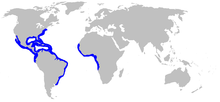Lemon shark
| Lemon shark | |
|---|---|
 |
|
| Scientific classification | |
| Kingdom: | Animalia |
| Phylum: | Chordata |
| Class: | Chondrichthyes |
| Subclass: | Elasmobranchii |
| Superorder: | Selachimorpha |
| Order: | Carcharhiniformes |
| Family: | Carcharhinidae |
| Genus: | Negaprion |
| Species: | N. brevirostris |
| Binomial name | |
|
Negaprion brevirostris (Poey, 1868) |
|
 |
|
| Range of the lemon shark | |
| Synonyms | |
|
Carcharias fronto Jordan & Gilbert, 1882 |
|
Carcharias fronto Jordan & Gilbert, 1882
Hypoprion brevirostris Poey, 1868
The lemon shark (Negaprion brevirostris) is a stocky and powerful shark. A member of the family Carcharhinidae, lemon sharks can grow to 3.4 metres (11 ft) in length. They are often found in shallow subtropical waters and are known to inhabit and return to specific nursery sites for breeding. Often feeding at night, these sharks use electroreceptors to find their main source of prey, fish. Lemon sharks enjoy the many benefits of group living such as enhanced communication, courtship, predatory behavior, and protection. This species of shark gives birth to live young, and the females are polyandrous and have a reproductive cycle. Lemon sharks are not thought to be a large threat to humans.
The lemon shark was first named and described in 1868 by Felipe Poey. He originally named it Hypoprion brevirostris, but later renamed it Negaprion brevirostris. The lemon shark has also appeared in literature as Negaprion fronto and Carcharias fronto (Jordan and Gilbert, 1882), Carcharias brevirostris (Gunther, 1870), and Carcharhinus brevirostris (Henshall, 1891).
The shark's yellow colouring serves as a perfect camouflage when swimming over the sandy seafloor in its coastal habitat. The lemon shark commonly attains a length of 2.4 to 3.1 m (7.9 to 10.2 ft) and a weight up to 90 kg (200 lb) by adulthood, although sexual maturity is attained at 2.24 m (7.3 ft) in males and 2.4 m (7.9 ft) in females. The maximum recorded length and weight is 3.43 m (11.3 ft) and 183.7 kg (405 lb), respectively. It has a flattened head with a short, broad snout, and the second dorsal fin is almost as large as the first. Lemon sharks have electroreceptors concentrated in their heads, called the ampullae of Lorenzini. These receptors detect electrical pulses emitted by potential prey and allow these nocturnal feeders to sense their prey in the dark.
...
Wikipedia

